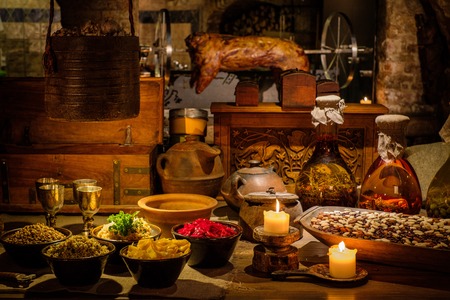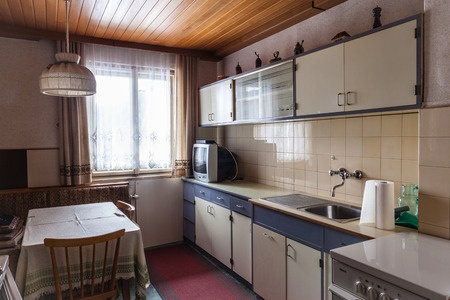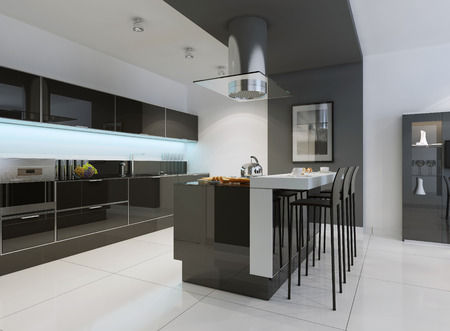Industrial. Mid-century modern. Scandinavian. Japan-inspired.
These days, kitchens seem to be a blank canvas for creative design experiments starring innovative materials, textures, colors, and layouts. Still, style trends aren’t the only aspect of kitchen design that’s constantly changing: the concept of the kitchen itself has evolved through history. Once purely functional, at-home culinary havens have by now become spaces dedicated to visual expressions of style, status, and personality. But how did it all begin, and what prospects does the future of interior design have in store for us when it comes to kitchen aesthetics?
Middle Ages: Early Kitchens Moving Into Homes

In European homes in the Middle Ages (5th-15th century), cooking was mostly done over open flames, and the hearth was the primary source of safety, heat, and light. Soot and smoke were a major problem back then, and kitchens were therefore often located at the back of the house or castle’s great hall. The upper class stayed away from the kitchen since it was considered a dirty place fit only for slaves and servants to labor in. Over time, however, home layouts gradually changed, and the great hall was divided into two separate units soon after the invention of the chimney in the 16th century. One of the rooms created by the hall partition became the living room and the other turned into the kitchen as we know it today.
18th and 19th Century: Kitchens Turning Suave
During the 18th and 19th centuries, the change in economic and political trends exerted a major impact on kitchen design and functionality. This was the era in which the French cooking style, characterized by formal table settings and strict etiquette, saw a rise in popularity across Europe and America. Chic kitchens at the time were packed with diverse gadgets, cutlery, and dishes, and the food cooked in the kitchen was often laced with spices and exotic ingredients imported from Asia. In this era, kitchens were located on the ground floor, away from the main entrance, and technological advance such as introduction of plumbed water, electricity, and coal, gas, and cast iron stoves changed the look and purpose of the kitchen, reducing labor time and the need for manpower. In servant-less homes, kitchens were often an integral part of the living area, but they often in a room towards the back of the house, away from the formal reception area.
Early 1900s: Kitchen Conveniences Marching In
The industrial revolution produced dozens of technological inventions which impacted kitchen design. Smaller and lighter gas stoves replaced their coal-powered counterparts, and plumbed water became the standard in most households. In early 1900s, factory production of kitchen gadgets brought about a drop in appliance prices, allowing members of lower classes to stock their cooking heavens with state-of-the-art conveniences. The range of kitchen storage units on offer, however, was limited until 1910, when the Hoosier Manufacturing Company came up with a freestanding unit with upper and lower cabinets, built-in sifters, racks, and pullout worktop, which made kitchen work easier and faster.
After World War I: Frankfurt Kitchen Rolls Out
In post-war Germany, housing was a major issue, and the kitchen layout had to change so as to ensure peak efficiency in as little space as possible. Designed by Austrian architect Margarete Lihotzky, the world’s first low-cost, mass produced fitted kitchen (known as Frankfurt Kitchen) was rolled out in 1926. With a revolutionary design that allowed all kitchen extras to be stored within reach, the Frankfurt Kitchen was the forerunner of the kitchen work triangle concept and minimalist 21st-century kitchens.
1930’s and 1940’s: Clean, Safe, and Efficient
In 1930s and 1940s, fitted kitchens became popular in the U.S. and Europe. The efficient design brought together appliances and cabinetry, creating a more functional and aesthetically pleasing kitchen. In addition to that, the invention of time- and labor-saving tools and devices such as the toaster, blender, and microwave allowed homeowners to handle all the chores singlehandedly without waste of time. After World War II, speedy technological development produced modern kitchen appliances such as quiet ventilation hoods, fridges, stainless steel ovens, dishwashers, and countertops. As for stylistic tendencies, designers and homeowners became increasingly fond of neutral tones, balanced contrasts, mid-century modern and art deco details, and open-plan layout. All these changes helped the kitchen gradually merge with the main living area, and the fitted kitchen fell out of vogue.

From 1960s Onward: A Homeowner’s Pride
From 1960s onward, the kitchen came into the limelight of interior design and became the hub of culinary experiments, provisional entertainment area, and a spot to display luxury cookware at the same time. Though the kitchen look was slowly becoming standardized, the cooking area remained into a unique canvas for aesthetic design experiments rather than a merely functional part of the home. From this era onwards, fast-paced technological progress kept pushing the frontiers of kitchen design forward, drastically cutting time required for everyday kitchen chores such as cooking and cleaning.
21st Century: Kitchens Gone Automatic

Today, kitchen design is evolving faster than ever. From remotely operated appliances and eco-friendly materials to wireless and energy-efficient tech, the 21st-kitchen is a nutshell trophy. The open-plan kitchen outfitted with first-rate islands is seamlessly integrated with the dining room designed following in mid-century modern, Nordic, or industrial footsteps. As for design styles, kitchens today boast sleek lines, light hues, and minimalist designs. Scandinavian furniture made from wood, neutral hues, and natural fabrics are a major kitchen design trend these days, along with the use of houseplants, artwork, and multipurpose furnishings.
In the years to come, designers expect Nordic minimalism to merge with Japanese love of natural elements: in fact, style known as Japandi is already making big waves on the home and kitchen décor scene. Apart from ethnic-inspired styles, stylish kitchens today rock vintage, industrial, and eco-friendly guise, and the biggest kitchen look trends include use of muted colors with strong accents for contrast, tone-on-tone designs, internal cabinetry lighting, brushed steel appliance shells, multipurpose kitchen spaces, and modular furnishings.
Kitchen design has come a long way since the time when the cooking area was considered more of the dirt than the heart of a home. Formerly a secluded spot at the back of the house to be used by servants only, the kitchen has by now become a rightful part of open-plan living areas where functionality and aesthetics collide. In the years to come, kitchen design will continue changing in line with homeowners’ stylistic preferences – in fact, we’re already seeing LCD TV screens, aquariums, and treadmills migrating to the spot once dedicated to culinary experiments only. Although it remains to be seen how kitchen design will change in the years to come, one thing is certain beyond doubt: in the future, the kitchen will never again be a place homeowners loathe spending time in.